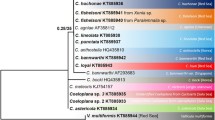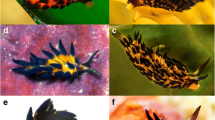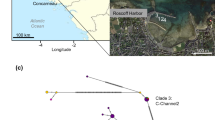Abstract
Eurythoe complanata (Pallas 1766) has been considered a cosmopolitan species with a great morphological similarity across its geographic range. To elucidate whether E. complanata is actually a single species, genetic (cytochrome oxidase subunit I and allozymes) and morphological differences were compared among specimens from the Pacific, Caribbean, and South Atlantic Oceans. Large levels of COI divergence (10–22%) and diagnostic allozyme loci identified three cryptic species: one in the eastern Pacific and two in the Atlantic, with one being morphologically differentiated and found only in islands. COI sequences between Pacific and Atlantic lineages were much more divergent than those of other transisthmian invertebrates, indicating their split before the Panama Isthmus closure or a faster evolutionary rate of COI for this species. The existence of two Atlantic species may be a consequence of parapatric speciation followed by a secondary invasion or even a sympatric speciation in the Atlantic oceanic islands.




Similar content being viewed by others
References
Anisimova M, Gascuel O (2006) Approximate likelihood ratio test for branches: a fast, accurate and powerful alternative. Syst Biol 55:539–552
Barroso R, Paiva PC (2007) Amphinomidae (Annelida: Polychaeta) from Rocas Atoll, Northeastern Brazil. Arq Mus Nac Rio de Jan 65:357–362
Bastrop R, Blank M (2006) Multiple invasions—a polychaete genus enters the Baltic Sea. Biol Invasions 8:1195–1200
Bhaud M (1972) Identification des larves d’Amphinomidae (Annélides Polychètes) recueillies près de Nosy-Bé (Madagascar) et problèmes biologiques connexes. Cah ORSTOM sér Océanogr 10:203–216
Blank M, Laine AO, Jürss K, Bastrop R (2007) Molecular identification key based on PCR/RFLP for three polychaete sibling species of the genus Marenzelleria, and the species’ current distribution in the Baltic Sea. Helgol Mar Res 62:129–141
Boury-Esnault N, Klautau M, Bezac C, Wulff J, Solé-Cava AM (1999) Comparative study of putative conspecific sponge populations from both sides of the Isthmus of Panama. J Mar Biol Assoc UK 79:39–50
Bowen BW, Bass AL, Muss A, Carlin JL, Robertson DR (2006) Phylogeography of two Atlantic squirrelfishes (Family Holocentridae): exploring links between pelagic larval duration and population connectivity. Mar Biol 149:899–913
Breton S, Dufresne F, Desrosiers G, Blier PU (2003) Population structure of two northern hemisphere polychaetes, Neanthes virens and Hediste diversicolor (Nereididae), with different life-history traits. Mar Biol 142:707–715
Brown CW (1990) The significance of the South Atlantic Equatorial Countercurrent to the ecology of the green turtle breeding population of Ascension Island. J Herpetol 24:81–84
Chamberlin RV (1919) The Annelida Polychaeta. Mem Mus Comp Zool Harv 48:1–514
Coyne JA, Orr HA (2004) Speciation. Sinauer Associates, Sunderland
Dawson MN (2005) Incipient speciation of Catostylus mosaicus (Scyphozoa, Rhizostomeae, Catostylidae), comparative phylogeography and biogeography in south-east Australia. J Biogeogr 32:515–533
Day JH (1951) The polychaete fauna of South Africa. Part 1. The intertidal and estuarine Polychaeta of Natal and Moçambique. Ann Natal Mus 12:1–67
Diniz-Filho JAF, Telles MPC, Bonatto SL, Eizirik E, Freitas TRO, de Marco P, Santos FR, Solé-Cava AM, Soares TN (2008) Mapping the evolutionary twilight zone: molecular markers, populations and geography. J Biogeogr 35:753–763
Ebbs NK (1966) The coral-inhabiting polychaetes of the northern Florida reef tract. Part I. Aphroditidae, Polynoidae, Amphinomidae, Eunicidae and Lysaretidae. Bull Mar Sci 16:485–555
Excoffier L, Laval G, Schneider S (2005) Arlequin ver. 3.0: an integrated software package for population genetics data analysis. Evol Bioinform Online 1:47–50
Farrapeira CMR, de Melo AVOM, Barbosa DF, da Silva KME (2007) Ship hull fouling in the Port of Recife, Pernambuco. Braz J Oceanogr 55:207–221
Fauvel P (1914) Annélides polychètes non-pélagiques provenant des campagnes de l’Hirondelle et de la Iles Gambier Faune de l’Empire français. Office de la Recherche Scientifique Coloniale, Paris
Fauvel P (1947) Annélides polychètes de Nouvelle-Caledonie et des Iles Gambier Faune de l’Empire français. Office de la Recherche Scientifique Coloniale, Paris
Floeter SR, Rocha LA, Robertson DR, Joyeux JC, Smith-Vaniz WF, Wirtz P, Edwards AJ, Barreiros JP, Ferreira CEL, Gasparini JL, Brito A, Falcon JM, Bowen BW, Bernardi G (2008) Atlantic reef fish biogeography and evolution. J Biogeogr 35:22–47
Folmer O, Black M, Hoeh W, Lutz R, Vrijenhoek R (1994) DNA primers for amplification of mitochondrial cytochrome C oxidase subunit I from metazoan invertebrates. Mol Mar Biol Biotech 3:194–299
Glasby CJ (2005) Polychaete distribution patterns revisited: an historical explanation. Mar Ecol 26:235–245
Grassle JP, Grassle JF (1976) Sibling species in the marine pollution indicator Capitella (polychaeta). Science 192:567–569
Guindon S, Gascuel O (2003) A simple, fast, and accurate algorithm to estimate large phylogenies by maximum likelihood. Syst Biol 52:696–704
Hartman O (1940) Polychaetous Annelids. Part 2. Chrysopetalidae to Goniadidae. Allan Hancock Pac Exped 7:173–287
Hartman O (1948) The marine annelids erected by Kinberg, with notes on some other types in the Swedish State Museum. Ark Zool 42A:1–137
Hartman O (1954) Marine annelids from the northern Marshall Islands. Professional Papers of the US Geological Survey 260:619–644
Hickerson MJ, Gilchrist MA, Takebayashi N (2003) Calibrating a molecular clock from phylogeographic data: moments and likelihood estimates. Evolution 57:2216–2225
Hillis DM, Moritz C, Mable BK (1996) Molecular systematics. Sinauer Associates, Sunderland
Horst R (1912) Polychaeta errantia of the Siboga Expedition. Part I. Amphinomidae. Siboga Expeditie. Leyden 24:1–43
Jolly MT, Viard F, Gentil F, Thiébaut E, Jollivet D (2006) Comparative phylogeography of two coastal polychaete tubeworms in the Northeast Atlantic supports shared history and vicariant events. Mol Ecol 15:1841–1855
Joly M, Jollivet D, Gentil F, Thiébaut E, Viard F (2005) Sharp genetic break between Atlantic and English Channel populations of the polychaete Pectinaria koreni, along the North coast of France. Heredity 94:23–32
Kinberg JGH (1857) Nya slägter och arter af Annelider. Öfv, Svenska Vetensk. Akad Förh 14:11–14
Kinberg JGH (1867) Annulata nova. Öfvers K VetenskAkad Förh 23:337–357
Klautau M, Russo CAM, Lazoski C, Boury-Esnault N, Thorpe JP, Solé-Cava AM (1999) Does cosmopolitanism in morphologically simple species result from overconservative systematics? A case study using the marine sponge Chondrilla nucula. Evolution 53:1414–1422
Knowlton N (1993) Sibling species in the sea. Annu Rev Ecol Syst 24:189–216
Knowlton N, Weigt LA (1998) New dates and new rates for divergence across the Isthmus of Panama. Proc Roy Soc Lond B 265:2257–2263
Kruse I, Reise K (2003) Reproductive isolation between intertidal and subtidal Scoloplos armiger (Polychaeta, Orbiniidae) indicates sibling species in the North Sea. Mar Biol 143:511–517
Kudenov JD (1974) The reproductive biology of Eurythoe complanata (Pallas, 1766) (Polychaeta: Amphinomidae). PhD thesis, University of Arizona
Kudenov JD (1995) Family Amphinomidae Lamarck, 1818. In: Blake JA, Hilbig B, Scott PH (eds) Taxonomic atlas of the benthic fauna of the Santa Maria Basin and Western Santa Barbara Channel, vol 5: the Annelida. Part 2. Polychaeta: Phyllodocida (Syllidae and Scale-bearing Families), Amphinomida and Eunicida. Santa Barbara Museum of Natural History, Santa Barbara, pp 207–228
Kumar S (1996) PHYLTEST: program for testing phylogenetic hypotheses version 2.0. Institute of Molecular and Evolutionary Genetics and Department of Biology, Pennsylvania State University, University Park
Lazoski C, Solé-Cava AM, Boury-Esnault N, Klautau M, Russo CAM (2001) Cryptic speciation in a high gene flow scenario in the oviparous marine sponge Chondrosia reniformis Nardo, 1847. Mar Biol 139:421–429
Lessios HA (2008) The great American schism: divergence of marine organisms after the rise of the Central American isthmus. Annu Rev Ecol Evol Syst 39:63–91
Lessios HA, Kessing BD, Robertson BR (1998) Massive gene flow across the world’s most potent marine biogeographic barrier. Proc Roy Soc Lond B 265:583–588
Lessios HA, Kane J, Robertson DR (2003) Phylogeography of the pantropical sea urchin Tripneustes: contrasting patterns of population structure between oceans. Evolution 57:2026–2036
Lima D, Freitas JE, Araujo ME, Solé-Cava AM (2005) Genetic detection of cryptic species in the frillfin goby Bathygobius soporator. J Exp Mar Biol Ecol 320:211–223
Maltagliati F, Peru AP, Casu M, Rossi F, Lardicci C, Curini-Galletti M, Castelli A (2000) Is Syllis gracilis (Polychaeta: Syllidae) a species complex? An allozyme perspective. Mar Biol 136:871–879
Maltagliati F, Casu M, Castelli A (2004) Morphological and genetic evidence supports the existence of two species in the genus Ophelia (Annelida, Polychaeta) from the Western Mediterranean. Biol J Linn Soc 83:101–113
Manchenko GP (1994) Handbook of detection of enzymes on electrophoretic gels. CRC, Ann Arbor
Manchenko GP, Radashevsky VI (2002) Genetic differences between two sibling sympatric Dipolydora species (Polychaeta: Spionidae) from the Sea of Japan, and a new species description. J Mar Biol Assoc UK 82:193–199
Marko PB (2002) Fossil calibration of molecular clocks and the divergence times of geminate species pairs separated by the Isthmus of Panama. Mol Biol Evol 19:2005–2021
Marsden JR (1960) Polychaetous annelids from the shallow waters around Barbados and other islands of the West Indies, with notes on larval forms. Can J Zool 38:989–1020
McCartney MA, Keller G, Lessios HA (2000) Dispersal barriers in tropical oceans and speciation in Atlantic and eastern Pacific sea urchins of the genus Echinometra. Mol Ecol 9:1391–1400
McIntosh WC (1885) Report on the Annelida Polychaeta collected by the H.M.S. Challenger during the years 1873–1876. Report on the scientific results of the voyage of H.M.S. Challenger during the years 1873–1876 under the command of the captain George S. Nares, R.N., F.R.S. and the late captain Frank Tourle Thomson, R.N. Zoology 12:1–554
Mendez N, Paez-Osuna F (1998) Trace metals in two populations of the fireworm Eurythoe complanata from Mazatlán Bay: effect of body size on concentrations. Environ Pollut 102:279–285
Mileikovsky SA (1961) Assignment of two rostraria-type polychaete larvae from the plankton of the northwest Atlantic to species Amphinome pallasi Quatrefages, 1865 and Chloenea atlantica McIntosh, 1885 (Polychaeta, Errantia, Amphinomorpha). Dokl Biol Sci 141:1109–1112
Miller MP (1997) Tools for population genetics analysis (TFPGA) 1.3: a windows program for the analysis of allozyme and molecular population genetics data. (http://www.marksgeneticsoftware.net/tfpga.htm)
Murphy RW, Sites JW, Buth DG, Haufler CH (1990) Proteins I: isozyme electrophoresis. In: Hillis DM, Moritz C (eds) Molecular systematics. Sinauer Associates, Sunderland, pp 45–126
Nakamura T, Tachikawa Y, Kitamura M, Ohno O, Suganuma M, Daisuke Uemura D (2008) Complanine, an inflammation-inducing substance isolated from the marine fireworm Eurythoe complanata. Org Biomol Chem 6:2058–2060
Nei M (1978) Estimation of average heterozygosity and genetic distance from a small number of individuals. Genetics 89:583–590
Nei M (1987) Molecular evolutionary genetics. Columbia University Press, New York
Nei M, Kumar S (2000) Molecular evolution and phylogenetics. Oxford University Press, New York
Nóbrega R, Solé-Cava AM, Russo CAM (2004) High genetic homogeneity of an intertidal marine invertebrate along 8000 km of the Atlantic coast of the Americas. J Exp Mar Biol Ecol 303:173–181
Nunez J, Brito MC, Ocana O (1991) Anélidos poliquetos de Canarias: familia Amphinomidae. Cah Biol Mar 32:469–476
Nygren A, Eklöf J, Pleijel F (2009) Arctic-boreal sibling species of Paranaitis (Polychaeta, Phyllodocidae). Mar Biol Res 5:315–327
Nylander JAA (2004) MrModeltest V2. Program distributed by the author. Evolutionary Biology Centre, Uppsala University, Uppsala
O’Hara TD, Poore GCB (2000) Patterns of distribution for southern Australian marine echinoderms and decapods. J Biogeogr 27:1321–1335
Osborn K, Rouse GW, Goffredi SK, Robison BH (2007) Description and relationships of Chaetopterus pugaporcinus, an unusual pelagic polychaete (Annelida, Chaetopteridae). Biol Bull 122:40–54
Paiva PC (2006) Soft-bottom polychaetes of the Abrolhos Bank. In: Dutra GF, Allen GR, Werner T, McKenna SA (eds) A rapid marine biodiversity assessment of the Abrolhos Bank, Bahia, Brazil, vol 38. Conservation International, Washington DC, pp 87–90
Pallas PS (1766) Miscellanea zoologica quibus novae imprimis atque obscurae Animalium species describuntur et observationibus iconibusque illustrantur. Petrum Van Cleef, Hagae Comitum
Palumbi SR (1992) Marine speciation on a small planet. Trends Ecol Evol 7:114–118
Palumbi SR (1994) Genetic divergence, reproductive isolation, and marine speciation. Annu Rev Ecol Syst 25:547–572
Pfenninger M, Schwenk K (2007) Cryptic animal species are homogeneously distributed among taxa and biogeographical regions. BMC Evol Biol 7:121
Posada D, Crandall KA (1998) Modeltest: testing the model of DNA substitution. Bioinformatics 14:817–818
Potts FA (1909) Polychaeta of the Indian Ocean. Pt. I. Amphinomidae. Trans Linn Soc Lond 12:355–371 (series 2)
Ramos-Onsins SE, Rozas J (2002) Statistical properties of new neutrality tests against population growth. Mol Biol Evol 19:2092–2100
Rice SA, Karl S, Rice KA (2008) The Polydora cornuta complex (Annelida: Polychaeta) contains populations that are reproductively isolated and genetically distinct. Invert Biol 127:45–64
Rocha L (2003) Patterns of distribution and processes of speciation in Brazilian reef fishes. J Biogeogr 30:1161–1171
Rocha LA, Bowen BW (2008) Speciation in coral-reef fishes. J Fish Biol 72:1101–1121
Rocha LA, Robertson DR, Roman J, Bowen BW (2005) Ecological speciation in tropical reef fishes. Proc Roy Soc Lond B 272:573–579
Ronquist F, Huelsenbeck JP (2003) MRBAYES 3: Bayesian phylogenetic inference under mixed models. Bioinformatics 19:1572–1574
Rozas J, Sánchez-DelBarrio JC, Messenguer X, Rozas R (2003) DnaSP, DNA polymorphism analyses by the coalescent and other methods. Bioinformatics 19:2496–2497
Rundle HD, Nosil P (2005) Ecological speciation. Ecol Lett 8:336–352
Sarver SK, Silberman JD, Walsh PJ (1998) Mitochondrial DNA sequence evidence supporting the recognition of two subspecies of the Florida spiny lobster Panulirus argus. J Crustac Biol 18:177–186
Scaps P, Rouabah A, Leprêtre A (2000) Morphological and biochemical evidence that Perinereis cultrifera (Polychaeta: Nereididae) is a complex of species. J Mar Biol Assoc UK 80:735–736
Schulze A (2006) Phylogeny and genetic diversity of palolo worms (Palola, Eunicidae) from the Tropical North Pacific and the Caribbean. Biol Bull 210:25–37
Schulze SR, Rice SA, Simon JL, Karl SA (2000) Evolution of poecilogony and the biogeography of North American populations of the polychaete Streblospio. Evolution 54:1247–1259
Sneath PHA, Sokal RR (1973) Principles of numerical taxonomy. Freeman, San Francisco
Sokal RR, Rholf FJ (1995) Biometry. Freeman, New York
Solé-Cava AM, Thorpe JP (1986) Genetic differentiation between morphotypes of the marine sponge Suberites ficus (Demospongiae, Hadromerida). Mar Biol 93:247–253
Tajima F (1989) Statistical method for testing the neutral mutation hypothesis by DNA polymorphism. Genetics 123:585–595
Takezaki N, Razhetsky A, Nei M (1995) Phylogenetic test of the molecular clock and linearized trees. Mol Biol Evol 12:823–833
Tamura K, Dudley J, Nei M, Kumar S (2007) MEGA4: molecular evolutionary genetics analysis (MEGA) software version 4.0. Mol Biol Evol 24:1596–1599
Thorpe JP, Solé-Cava AM (1994) The use of allozyme electrophoresis in invertebrate systematics. Zool Scr 23:3–18
van Oppen MJH, Klerk H, Olsen JL, Stam WT (1996) Hidden diversity in marine algae: some examples of genetic variation below the species level. J Mar Biol Assoc UK 76:239–242
Vázquez-Núñez R, Méndez N, Green-Ruíz C (2007) Bioaccumulation and elimination of Hg in the fireworm Eurythoe complanata (Annelida: Polychaeta) from Mazatlan, Mexico. Arch Environ Contam Toxicol 52:541–548
Westheide W, Schmidt H (2003) Cosmopolitan versus cryptic meiofaunal polychaete species: an approach to a molecular taxonomy. Helgol Mar Res 57:1–6
Xia X, Xie Z (2001) DAMBE: software package for data analysis in molecular biology and evolution. J Hered 92:371–373
Xia X, Xie Z, Salemi M, Chen L, Wang Y (2003) An index of substitution saturation and its application. Mol Phylogenet Evol 26:1–7
Zigler KS, Lessios HA (2004) Speciation on the coasts of the new world: phylogeography and the evolution of bindin in the sea urchin genus Lytechinus. Evolution 58:1225–1241
Acknowledgments
This work resulted from the Masters Dissertation of RB at the National Museum of Federal University of Rio de Janeiro, with a fellowship of CNPq. Part of this work was done during a sabbatical year of PCP at the Smithsonian Tropical Research Institute (STRI), Panama, with a fellowship of CNPq. PCP is grateful to the STRI Staff, especially to Nancy Knowlton, for providing lab facilities, and Javier Jara for his intense collaboration in both field and lab work in Panama. The authors are thankful to Luiz Rocha (University of Hawaii) for collecting San Tomé (Africa) samples and to Andrew Cabrinovic and Emma Sherlock (The Natural History Museum) for the loan of specimens. The authors are thankful to the referees, for their very thorough and helpful comments. This work was supported by grants from National Science Foundation (NSF), USA and Conselho Nacional de Desenvolvimento Científico e Tecnológico (CNPq), Coordenadoria de Aperfeiçoamento de Pessoal de Nível Superior (CAPES), and Fundação Carlos Chagas Filho de Amparo a Pesquisa do Estado do Rio de Janeiro (FAPERJ), Brazil.
Author information
Authors and Affiliations
Corresponding author
Additional information
Communicated by J. P. Grassle.
Electronic supplementary material
Below is the link to the electronic supplementary material.
Rights and permissions
About this article
Cite this article
Barroso, R., Klautau, M., Solé-Cava, A.M. et al. Eurythoe complanata (Polychaeta: Amphinomidae), the ‘cosmopolitan’ fireworm, consists of at least three cryptic species. Mar Biol 157, 69–80 (2010). https://doi.org/10.1007/s00227-009-1296-9
Received:
Accepted:
Published:
Issue Date:
DOI: https://doi.org/10.1007/s00227-009-1296-9




